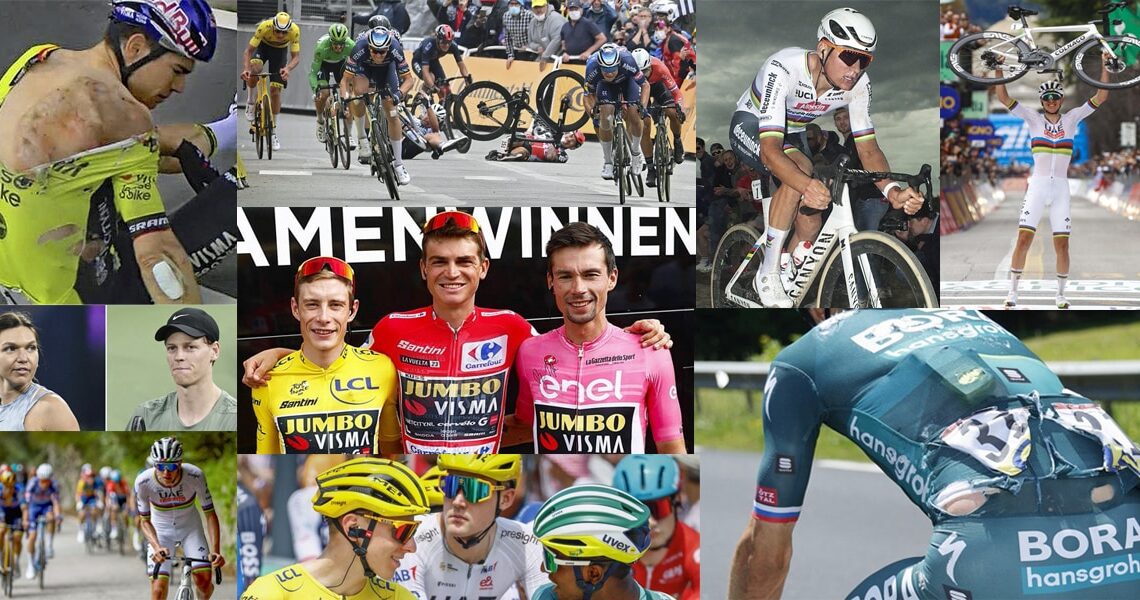In this week’s AIRmail newsletter, The Outer Line takes an in-depth look at trending cycling news: Pogačar wraps season with another rout …But anything can happen next year, anti-doping controversies continue, relevant rule changes in soccer, can SafeR help end the spate of fatal injuries?
SaferR…
# Catch up on pro cycling – and its context within the broader world of sports – with AIRmail … Analysis, Insight and Reflections from The Outer Line. You can subscribe to AIRmail here, and check out The Outer Line’s extensive library of articles on the governance and economics of cycling here. #
Key Takeaways:
Pog Finishes Historic Season with Rout at Lombardia
.. But Cycling’s Audience Has a Short Memory
Anti-Doping Standoff and Questions Continue
Will Rule Changes in Soccer Trickle Down to Cycling?
Can SafeR Help End the Spate of Fatal Injuries?
Il Lombardia – The cherry on the Pogačar cake
Tadej Pogačar put the finishing touches on what was arguably the best individual season in the sport’s history with a dominating performance at Il Lombardia this weekend– where he rode clear of all comers, including Olympic Champion Remco Evenepoel, to take his fourth consecutive win at the Italian monument. Pogačar further cemented his status as one of the best riders of all time by crossing the line 3’16 in front of second-place Evenepoel, netting the largest margin of victory in a monument since 1998 (Franco Ballerini at Paris-Roubaix) and at Lombardia since 1971 (Eddy Merckx with a gap of 3’31). The win, his 25th of the season, was his 7th career Monument, good enough to overtake Mathieu van der Poel for best among active riders and put him in 7th place all-time, tied with Tom Boonen and Fabian Cancellara, both of whom took twice as long to amass the same haul. Despite (and likely due to) the historic nature of his dominance this year, Pogačar’s win was generally met with a collective yawn from most of the viewing public, which is beginning to tire of his paint-by-numbers dominance. While Pogačar is a popular rider with millions of fans, cycling may eventually have a quandary if he continues to dominate the sport the way he has this year.
Pogačar domination
Pogačar’s sensational season is actually more of a reminder of just how short cycling’s collective memory can be, despite the universal impression that he and his thoroughly dominant UAE team have “solved” the sport and are henceforth unbeatable in the wake of yet another scorched-earth performance. For example, just twelve months ago, Visma-Lease a Bike was coming off an unprecedented Grand Tour sweep and a second-straight win over Pogačar at the Tour de France, due to incredible climbing and time trial performances from Jonas Vingegaard. Fans were concerned that the team would dominate this year as well but look what happened. And remember, even earlier this season, Mathieu van der Poel and his Alpecin-Deceuninck team stormed to three consecutive Monument victories at Milano-Sanremo, Tour of Flanders, and Paris-Roubaix – the former at the expense of Pogačar himself, and the latter due to Van der Poel’s dominance on the cobblestones that made him appear as close to unbeatable in the Spring Classics as any rider in the history of the sport. These examples, and the generally rapid rate of change at the top level of the sport in the last few years, should illustrate that while Pogačar may seem – and actually be – unbeatable at this point in time, there is no telling what may happen in 2025 and beyond.
It was only last year that Visma dominated
If and when Pogačar’s monopoly over major wins ever does stop, it is likely to come at the hands of just a few of his select and elite competitors. For example, the last 16 major one-day races (Monuments, Olympics, World Championships) have been won by just four separate riders (Pogačar, Van der Poel, Evenepoel, and Jasper Philipsen), with Pogačar and Van der Poel accounting for 69% of those wins. And, even if we account for stage races, just three riders, Pogačar, Primož Roglič, and Jonas Vingegaard, account for 61% of all Grand Tours overall wins over the last six seasons. This is likely due to inexorable change in modern racing, where we now see nearly every event raced at an all-out level. This tends to burn off 99% of the field, with only the very top few riders able to contest the win. This trend may be grating to watch and even disappointing for longtime fans of the sport, but it actually brings pro cycling in line with almost every other professional sport – many of which are dominated by a select few genetically gifted athletes and teams with the financial muscle to employ them.
Don’t forget Van der Poel
The heated confrontation between WADA and USADA for the moral and procedural high ground of anti-doping is still simmering, even as Reuters voluntarily withdrew articles critical of USADA after it was revealed that the writer curried favors to WADA officials. But overall, the temperature is rising due to controversies fueled by professional tennis and endurance sports performances – including pro cycling. The one-two punch of Simona Halep’s successful CAS appeal for a blood boosting drug and Jannik Sinner’s steroid positive – now being appealed by WADA to the CAS for a potential sanction – demonstrate the system’s volatility. Halep’s CAS appeal document was finally released and despite scientific evidence showing deliberate use of a blood boosting drug, the non-scientific CAS panel chose to rule in favor of her “contaminated supplement” defense. Critically, the CAS accepted blood test data Halep provided from a non-accredited lab for her defense, and rejected WADA expert testimony on the drug’s accepted pharmacokinetic effects. In a counter-volley regarding Sinner’s steroid case, WADA’s appeal may include better framing of the drug data – showing that it may have learned lessons from Halep’s “not my fault” defense. Halep is suing the supplement maker in her case for $10 million at the moment; what might Sinner do should he defend or lose his case?
Halep and Sinner
However, the intersection of international marathon and pro cycling this past week needs a deeper look – because the old adage, “if there’s smoke, there’s fire,” unfortunately applies to both sports. In marathon, the dominant win by Kenya’s Ruth Chepngetich at Chicago obliterated the women’s world record by more than two minutes, just slipping under the untouchable 2:10 barrier at 2:09:56. Her triumph has been tempered by three factors: the statistically ludicrous improvement over the previous record and of her prior personal best times under the tutelage of manager Federico Rosa (previously linked to doping in Kenyan athletics); the nearly eight-minute gap to the second-place finisher; and the wave of more than two dozen Kenyan distance running doping positives over the last two seasons. Simply put, there are more questions than answers, none bigger than the one posed by researchers earlier this year in which carbon-plate enhanced racing shoes alone do not explain why women’s marathon records have fallen so dramatically. Hence, the rising questions about doping.
Questions have been asked of Pogačar
Similar criticism has been placed on cycling due to Pogacar’s racing dominance and head-shaking breakaway performances over this season, particularly because of his faltering and being distanced in the 2023 Tour de France. His rebound – and surpassing the entirety of his peer group of elite grand tour and Classics winners – has led to open questions by analysts as to what is different about his genetics or his training preparation such that he has reached a level never before achieved in the sport. And it did not help him last week when, asked if he had ever doped, he provided a long-winded, well-rehearsed statement which included familiar phrases as “I won’t risk getting sick,” and “There will always be jealousy and suspicion” – when a simple “no” would have sufficed. Some of his peers like Evenepoel have gone so far to refer to his performances as “not normal,” and healthy skepticism will no doubt persist. But as we’ve said before and repeat here, until otherwise proven (and adjudicated), Pogacar’s record is clean and he is likely to continue setting records into the sport’s foreseeable future.
Are Pogačar’s performances ‘not normal’
In a decision that may reshape the professional football/soccer player transfer market, the European Court of Justice ruled in favor of a player’s right to free movement, undermining the system of transfer fees. The dispute was based on the exorbitant penalties often levied when a player chooses to end a contract to join a new team which often results in both the new team and the player having to pay compensation to the old team – penalty fees judged to be an impedance to competition and thus detrimental to the player’s opportunities. The general phrasing of the ruling could impact pro cycling, which has developed a pseudo-transfer market in which riders can buy out their contracts or otherwise find a team that will pay contract termination penalty on their behalf. As we’ve stated before, contracts are essentially written to be broken at some point, but by increasing the athlete’s rights, riders could successfully challenge or invalidate any penalty or transfer clauses if these impede their free movement to a team of their choosing. Could this change the current dynamic of youth development in the WorldTours? Given the trending lack of success of super teams to thrive by buying the best riders available at any cost – like Israel-Premier Tech and INEOS (especially with its recent Tom Pidcock debacle) – perhaps not, but the writing is on the wall for intrepid and talented riders to test the transfer waters.
Don’t crash solo
The UCI announced that as of next year, the so-called three-kilometer rule will no longer apply to riders who are involved in apparently solo crashes. Intended to remove unfair advantages for riders who simply happen to puncture or crash themselves in the last three kilometers, the new rule could also set up some harsh and unintended consequences. Some observers worried that certain struggling riders within a run-up or sprint could be incentivized to crash and take down other riders with them. No rule is ever perfect or without possible unintended results, but it will be interesting to see how this particular change will affect the lead out and run in to sprint stages.
Will the rule change affect the lead out and run in to sprint stages?
An interesting article by two Belfast academics in the low-visibility and under-appreciated Journal of Science and Cycling reviewed the status of safety measures in pro cycling. In discussing the implementation of the UCI SafeR, the articles suggests that the UCI, the CPA and the athletes themselves should “engage with injury epidemiology researchers to understand the injury risk profiles of the sport, to then develop injury prevention recommendations from this data and inform the implementation of them.” With team owners and principals like Jim Ratcliffe of Ineos and Richard Plugge of Visma-LAB continuing to draw attention to the need for a real and independent safety monitoring agency, it is hoped that progress can be made. On the other hand, as we have reported the last couple of weeks, there seems to be a surge in serious and fatal accidents in the last few years, some of which might well have been avoided with the utilization of stronger and already-existing technologies and policies. The editorial concludes that “through prospective injury surveillance, this will be the first step in allowing governing bodies/professional leagues to begin to identify the risk factors for injury, provide targeted education at acknowledging the socioecological context of injuries in cycling and create a proactive environment around improving athlete health by reducing injury risk.”
Improving athlete health by reducing injury risk
# Catch up on pro cycling – and its context within the broader world of sports – with AIRmail … Analysis, Insight and Reflections from The Outer Line. You can subscribe to AIRmail here, and check out The Outer Line’s extensive library of articles on the governance and economics of cycling here. #
The post Pogačar Wraps Stellar Season, Anti-Doping Standoff, Rule Changes in Soccer, SaferR … appeared first on PezCycling News.





